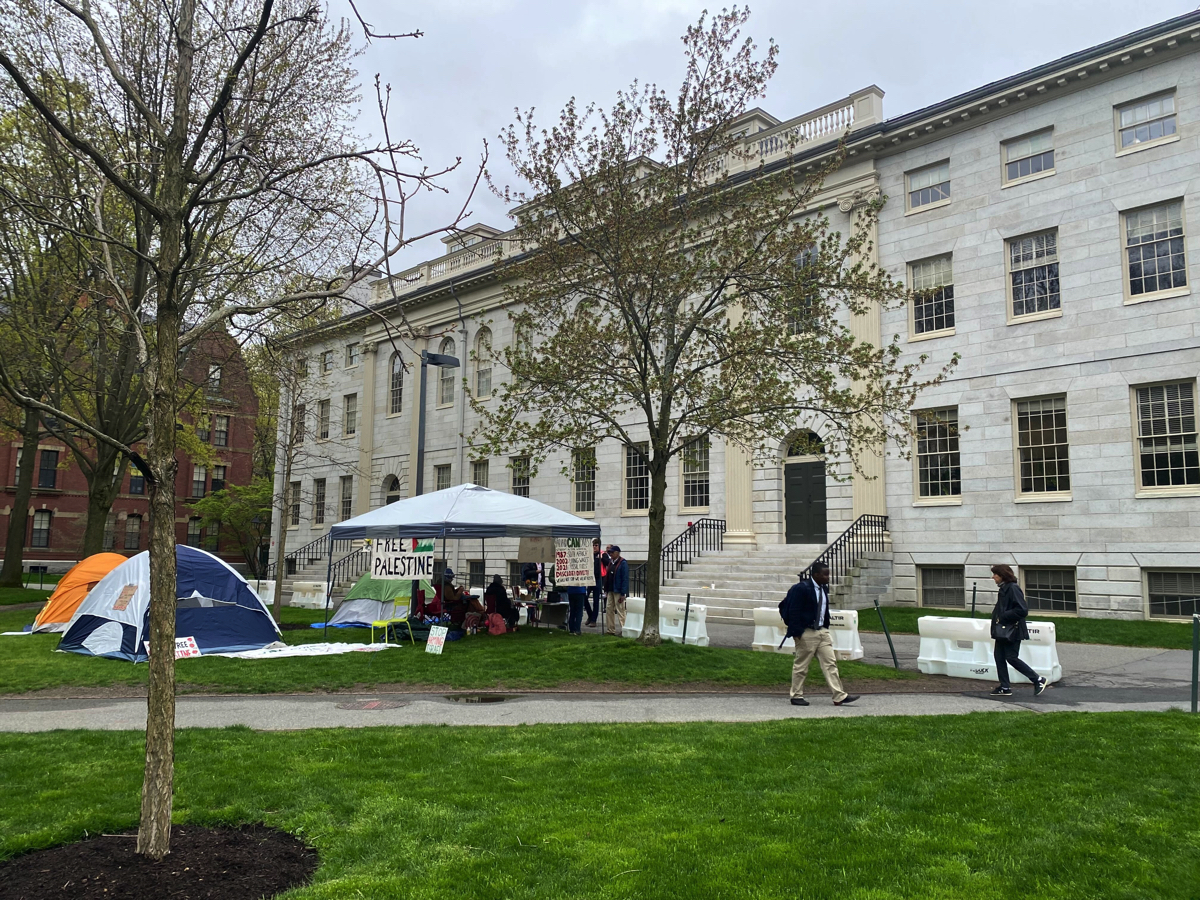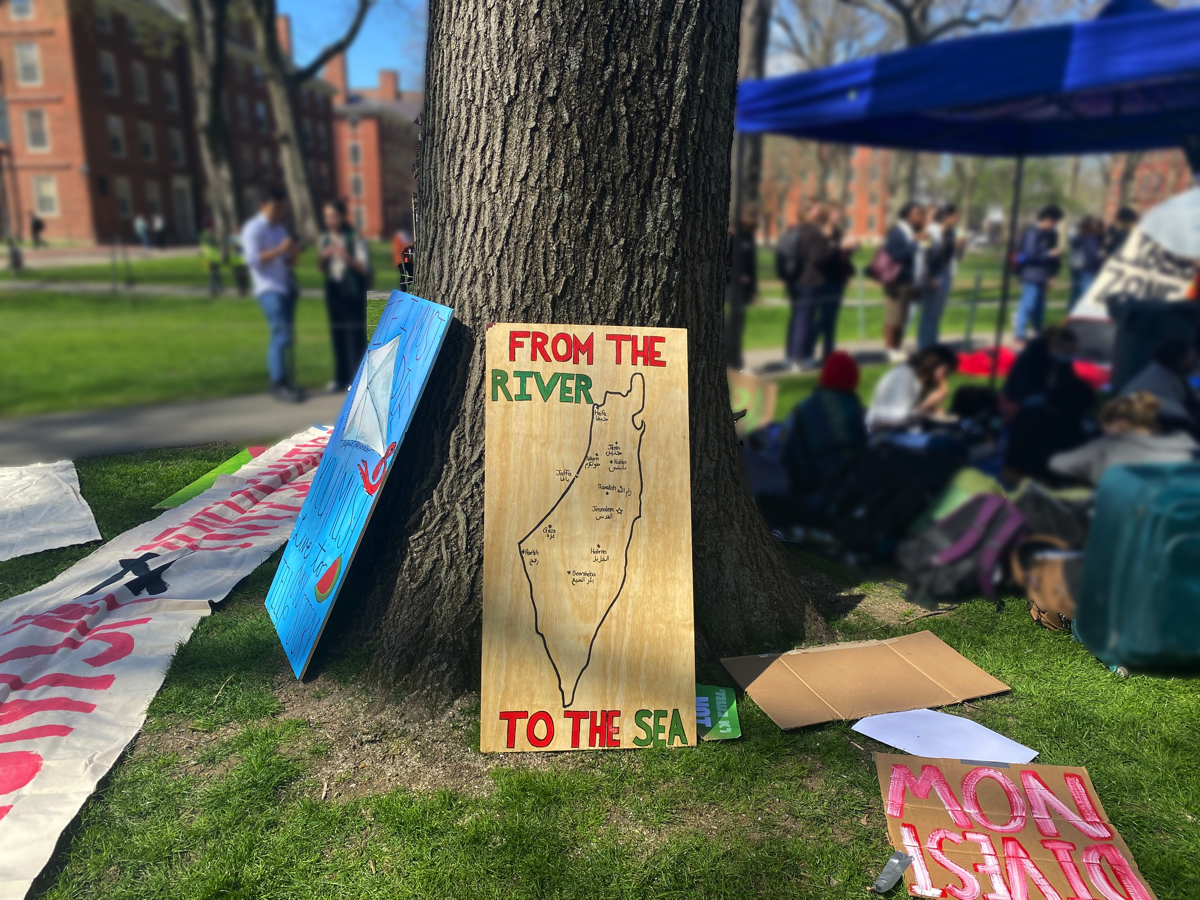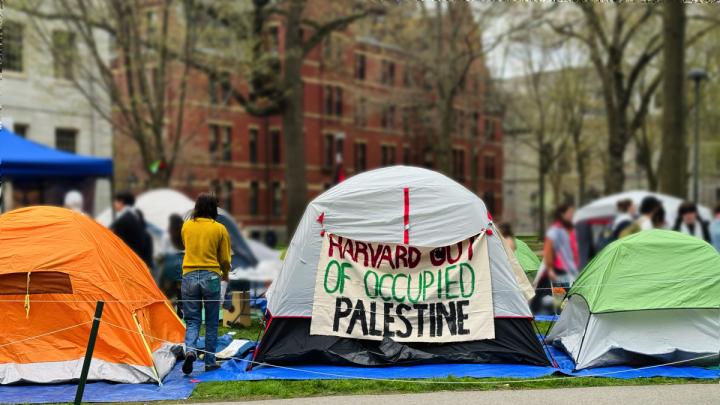UPDATE: May 3, 5 P.M.
Friday morning, Harvard Out of Occupied Palestine (HOOP), the group leading the pro-Palestine encampment in Harvard Yard, announced that it added tents on the east side of Massachusetts Hall—in Tercentenary Theatre—and set a deadline of Monday, May 7, at 5:00 P.M. for “the University to commence negotiations with HOOP on the implementation of its demands.”
Since the encampment began on April 24, protesters have steadily added tents, increasing the camp’s footprint on the western side of Harvard Yard (the Old Yard). Friday morning’s expansion into Tercentenary Theatre comes as the University begins its Commencement preparations. Though the encampment itself has physically expanded during the past 10 days, the number of protesters has not noticeably increased.

Harvard administrators have been collecting protesters’ ID information and have called students in front of the disciplinary Administrative Board. (The Crimson reported Monday that administrators summoned over more students to Ad Board, and HOOP today said the University gave “59 students and student workers disciplinary charges.”) In a news release, HOOP said that “the University has refused to meet with students and engage in good-faith negotiation.” College Dean Rakesh Khurana has been seen speaking with Harvard affiliates around the encampment and speaking with protesters on the west side of Massachusetts Hall.
In preparation for freshman move-out, which ends on May 12, Harvard is currently installing three-foot plastic water-filled barriers along the vehicle paths near the encampment. University spokesperson Jason Newton told The Crimson that the barricades will be placed in “positions of heavy traffic” in the Old Yard, but “will not encircle the entire Yard.” Access to the Yard remains limited to Harvard ID holders.
Read an in-depth account of the start of the encampment (posted on 4/24/24) below:
During the last week, pro-Palestine protesters at dozens of American universities have established encampments on school grounds. On Sunday, Harvard restricted access to the Yard, checking Harvard IDs at the gate and specifically noting that “structures, including tents and tables, are not permitted in the Yard without prior permission.”
Nonetheless, during a Wednesday afternoon rally against the administration’s Monday decision to suspend the Harvard Undergraduate Palestine Solidarity Committee, protesters rushed into a patch of grass and rapidly set up tents. Now, students seem primed to camp out in Harvard Yard.
A newly formed group, Harvard Out of Occupied Palestine, took responsibility for establishing the “liberated zone.” In an Instagram post, the group laid out three demands:
- “Disclose any and all investments—both institutional and financial—in Israel, the ongoing genocide in Gaza, and the occupation of Palestine.”
- “Divest from all such investments, and reinvest resources in Palestinian academic initiatives, communities, and culture.”
- “Drop all charges against students for their organizing and activism, and commit to ending the weaponization of the disciplinary policy.”

The Crimson reported that more than 500 people attended the initial protest, which began around noon. By 3 PM, the Yard had calmed. Around 70 students were sitting inside the encampment, whose borders are marked by a thin preexisting rope that Harvard Facilities uses to keep traffic off the spring grass. Protesters in reflective vests policed the edges, prepared to remove anyone whom the group deems not welcome in the encampment. (In November, Harvard investigated a physical confrontation between similar protest marshals and a counter-protester at Harvard Business School and indefinitely relieved a proctor of his duties for his involvement in the scuffle.)
In the encampment, protesters chatted among themselves, worked on their laptops, and ate snacks from three large tubs. During an organizational meeting of students in the encampment, conducted in hushed tones to avoid publication of details, leaders instructed students not to speak to administrators or press, but to show their Harvard ID if asked by an authority figure. (The group’s media liaison declined to speak with Harvard Magazine.) The protesters have divided themselves into groups based on their level of risk tolerance. Signs ring the encampment, including a map of Israel/Palestine with the words “from the river to the sea,” a phrase condemned by former president Claudine Gay in November.

It is not yet clear how the Harvard administration will respond. Monday morning, Yale administrators ordered a large encampment outside Beinecke Library to be cleared, and police arrested about 47 students. At Columbia, administrators threatened to remove an encampment outside Low Library, but have not yet done so.
Following Harvard’s tumultuous fall semester, administrators have been thinking and talking about free expression. In January, President Alan Garber and Harvard’s deans clarified University policies surrounding campus protest. After a tumultuous fall, this spring the University has sponsored events about civil discourse and is trying to foster respectful disagreement.
For now, the student protesters remain in Harvard Yard, tents damp from an afternoon shower.








